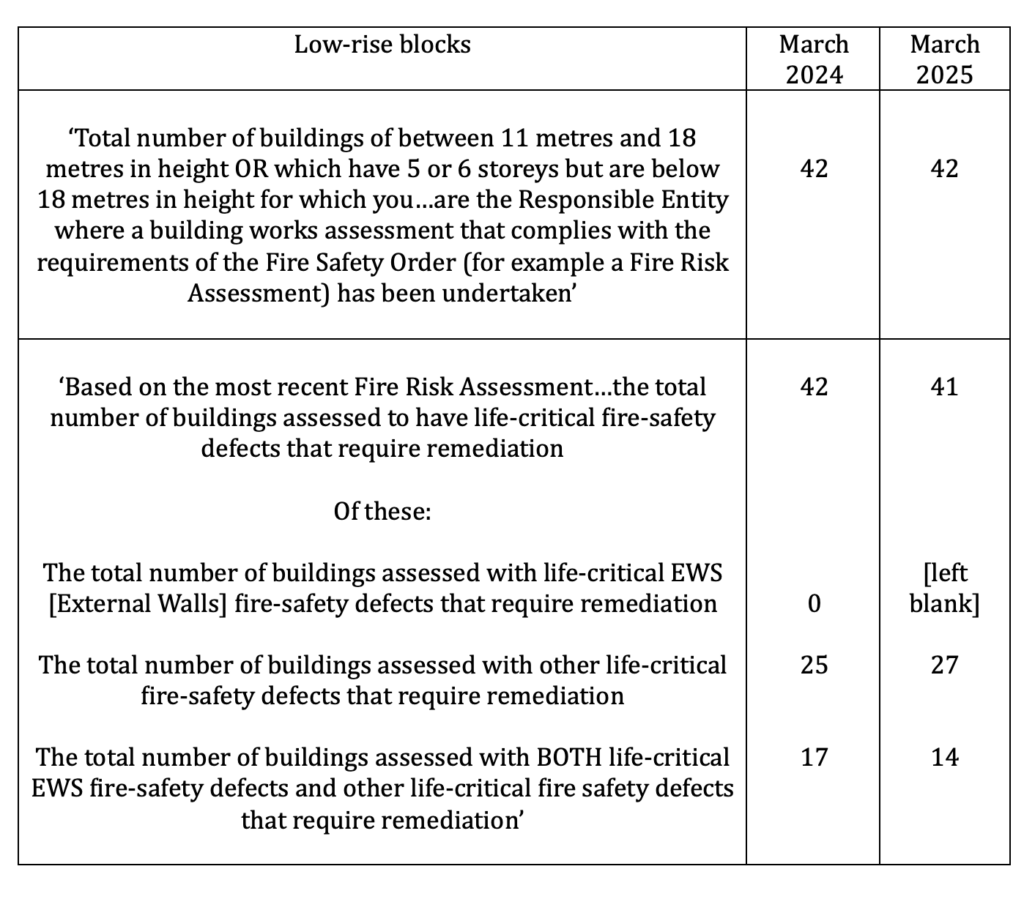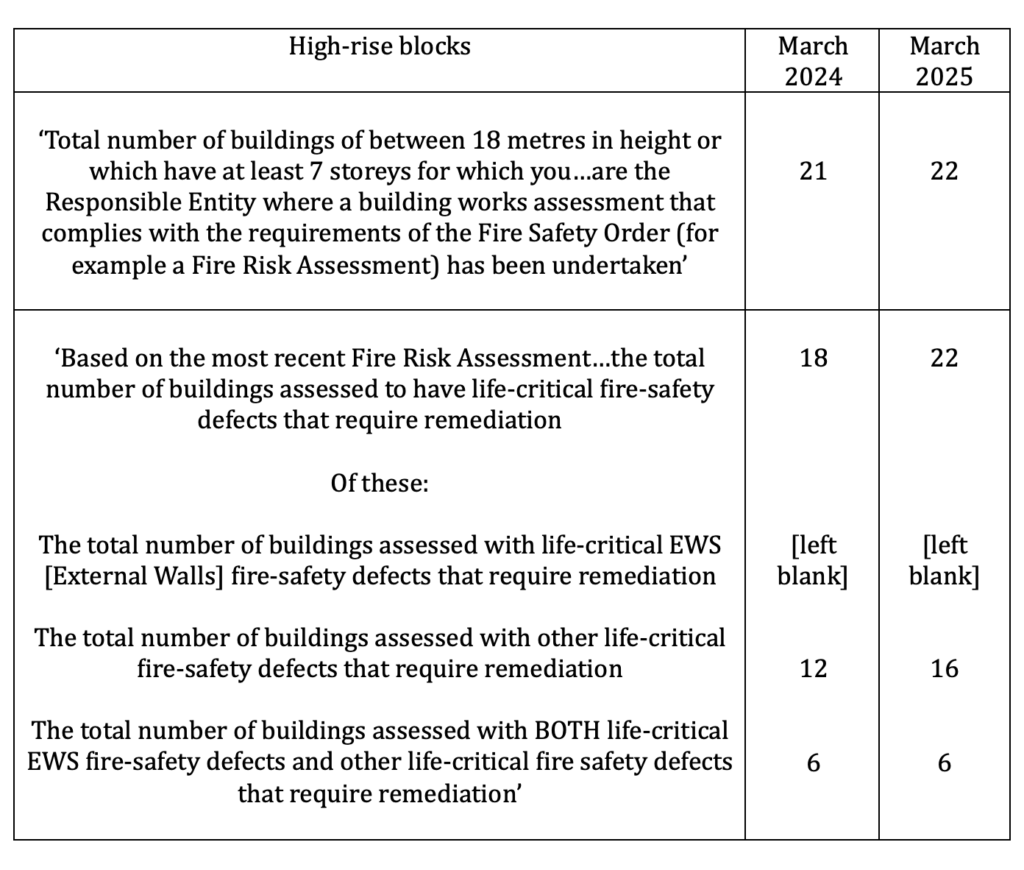Update: the latest official figures show that 63 of LBWF’s 64 low-rise and high-rise housing blocks are still not fire safe, mainly because of ‘Resources’, and ‘available budgets’
In 2020, triggered by the fallout from the Grenfell tragedy, LBWF finally addressed the fact that very few, if any, of its large and small housing blocks were fire safe, and began a large-scale remediation programme to put matters right.
It might be assumed that, by now, this programme would have delivered substantial results, leaving LBWF tenants free from worry.
But data recently released by the Regulator of Social Housing (RSH) under the Freedom of Information Act again shows that any such assumption would be hugely misplaced.
For the astonishing truth is that, as of March this year, all but one block still had what the RSH term ‘life-critical fire-safety defects’, some internal (flat entrance doors that didn’t give enough fire protection, windows that were packed with flammable wood, etc.), others concerning the External Wall System, typically the fact that the original cladding used on the buildings was found to be combustible.
Two tables, the first dealing with low-rise blocks, the second with high-rise blocks, summarise March 2025 data, and add, as a comparator, that for the year before:
What explains LBWF’s unimpressive performance?
To begin with, there is no doubt that LBWF started its remediation programme from a very disadvantageous position.
One calculation of the time suggested that to bring all of LBWF’s blocks up to the required fire safety standard would take an astonishing 14,525 separate ‘actions’.
And the reason for this was simply that, while LBWF’s annual Fire Risk Assessments continued to find that the blocks were full of defects, many serious, repairs had not necessarily followed (see links), thus generating a backlog.
Exactly why this happened is unclear, but it is possible that from around 2015 onwards, the LBWF leadership team’s excitement at cavorting with a host of newly arrived and pushy property developers, with their accompanying flunkies, was all encompassing, and edged out less glamorous concerns.
Second, it’s true, too, that as the current remediation programme has progressed, renewed scrutiny of the blocks has identified defects which were previously unknown, adding to the workload.
For example, in correspondence with the RSH during 2024, a LBWF staffer noted: ‘The flammable External Wall Insulation (EWI) has been removed from all our 18m+ buildings apart from Fred Wigg Tower and John Walsh Tower… where upon removal of the EWI, a second layer has been discovered’.
Third, the way that LBWF has administered the remediation programme seems to have added to the problems.
Initially, in 2020, LBWF promised it had ‘committed’ £40m. to ‘housing building safety improvements’, and four years later the LBWF Leader, Cllr. Grace Williams, upped this to ‘over £40m.’.
These statements gave the impression that the remediation programme would never be short of money. Indeed, when Cllr. Williams reflected on learning the lessons of Grenfell she pledged that, as far as local fire safety measures were concerned, LBWF would ‘“act wherever it was necessary”’.
However, behind the scenes, LBWF staff have told a markedly different story, with their returns to the RSH repeatedly citing ‘Resources’, and ‘available budgets’ as two of the three leading ‘barriers to delivery’.
It would appear, then, that ‘“act wherever it was necessary”’ was not meant literally.
Finally, given how the remediation programme has turned out, it might be expected that there would be significant discussion of it in the council chamber, and even in public.
But this turns out not to be the case, something that’s worth briefly considering.
First, some facts.
When the remediation programme was launched, LBWF put out a fairly long public statement, and included various appropriate reassurances. For example, it was underlined that, after ‘extensive examinations of all our high-rise buildings,’ none had problems with unsafe exterior cladding.
Thereafter, however, LBWF largely has refrained from further comment, even when the emerging evidence, as over the exterior cladding, was at odds with what had been initially claimed.
Furthermore, councillors on the relevant scrutiny committees seem to have been persuaded to follow suit.
In 2021, a year after the remediation programme’s launch, the Audit and Governance Committee twice discussed how it was proceeding, and in particular the number of separate ‘actions’ that had been either completed or were outstanding.
This was supposed to be the start of annual monitoring, but, in fact, the subject has never been returned to again.
The minutes of the Housing Scrutiny Committee tell a similar story. It has met more than 40 times since Grenfell, and discussed fire safety in local high-rise and low-rise blocks on five separate occasions.
But the last of these occasions was in October 2022.
Indeed, it’s only because, from April 2024, the RSH has required social housing providers to submit quarterly returns on fire safety that it’s been possible to fully track the LBWF remediation programme at all.
LBWF reticence may have been caused by several different factors, but political sensitivities surely must be one.
After all, ‘over £40m.’ is a large amount of money to spend out of the blue on one problem, and if LBWF were ever to come clean about why it was thought unavoidable, that would mean having to admit to, amongst other things, its tawdry record on fire safety prior to 2020
Better to remain guarded, and hope nobody asks awkward questions.
In short, this is classic Waltham Forest-itis: ‘see no evil, hear no evil, speak no evil’.


